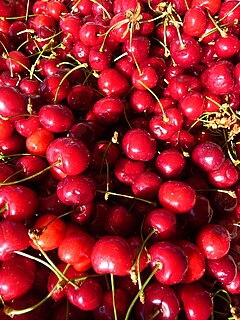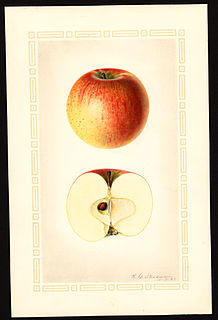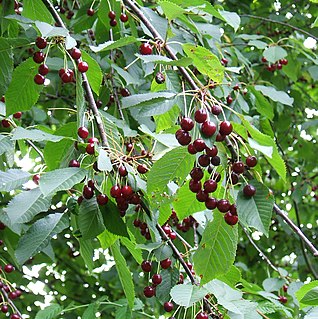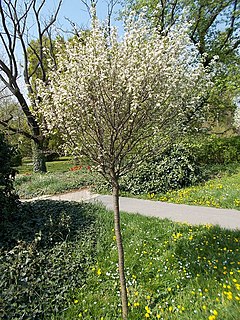
A cherry is the fruit of many plants of the genus Prunus, and is a fleshy drupe.

Fruit tree propagation is usually carried out vegetatively (non-sexually) by grafting or budding a desired variety onto a suitable rootstock.

Prunus cerasus is a species of Prunus in the subgenus Cerasus (cherries), native to much of Europe and southwest Asia. It is closely related to the sweet cherry, but has a fruit that is more acidic. Its sour pulp is edible.

Amelanchier, also known as shadbush, shadwood or shadblow, serviceberry or sarvisberry, juneberry, saskatoon, sugarplum, wild-plum or chuckley pear, is a genus of about 20 species of deciduous-leaved shrubs and small trees in the rose family (Rosaceae).

Malus is a genus of about 30–55 species of small deciduous trees or shrubs in the family Rosaceae, including the domesticated orchard apple – also known as the eating apple, cooking apple, or culinary apple. The other species are commonly known as crabapples, crab apples, crabtrees, or wild apples.

Pollination of fruit trees is required to produce seeds with surrounding fruit. It is the process of moving pollen from the anther to the stigma, either in the same flower or in another flower. Some tree species, including many fruit trees, do not produce fruit from self-pollination, so pollinizer trees are planted in orchards.
Dwarfing is a process in which a breed of animals or cultivar of plants is changed to become significantly smaller than standard members of their species. The effect can be induced through human intervention or non-human processes, and can include genetic, nutritional or hormonal means. Used most specifically, dwarfing includes pathogenic changes in the structure of an organism, in contrast to non-pathogenic proportional reduction in stature.
Cider apples are a group of apple cultivars grown for their use in the production of cider. Cider apples are distinguished from "cookers" and "eaters", or dessert apples, by their bitterness or dryness of flavour, qualities which make the fruit unpalatable but can be useful in cidermaking. Some apples are considered to occupy more than one category.
A rootstock is part of a plant, often an underground part, from which new above-ground growth can be produced. It could also be described as a stem with a well developed root system, to which a bud from another plant is grafted. It can refer to a rhizome or underground stem. In grafting, it refers to a plant, sometimes just a stump, which already has an established, healthy root system, onto which a cutting or a bud from another plant is grafted. In some cases, such as vines of grapes and other berries, cuttings may be used for rootstocks, the roots being established in nursery conditions before planting them out. The plant part grafted onto the rootstock is usually called the scion. The scion is the plant that has the properties that propagator desires above ground, including the photosynthetic activity and the fruit or decorative properties. The rootstock is selected for its interaction with the soil, providing the roots and the stem to support the new plant, obtaining the necessary soil water and minerals, and resisting the relevant pests and diseases. After a few weeks the tissues of the two parts will have grown together, eventually forming a single plant. After some years it may be difficult to detect the site of the graft although the product always contains the components of two genetically different plants.

The Hass avocado is a cultivar of avocado with dark green–colored, bumpy skin. It was first grown and sold by Southern California mail carrier and amateur horticulturist Rudolph Hass, who also gave it his name.

The 'Roxbury Russet' is an apple cultivar, believed to be the oldest apple cultivar bred in the United States, having first been discovered and named in the mid-17th century in the former Town of Roxbury, part of the Massachusetts Bay Colony southwest of Boston. It is known by several other names including 'Boston Russet', 'Putnam Russet', and 'Sylvan Russet'.

Rainier is a cultivar of cherry. It was developed in 1952 at Washington State University by Harold Fogle, and named after Mount Rainier. It is a cross between the 'Bing' and 'Van' cultivars.

Prunus necrotic ringspot virus (PNRSV) is a plant pathogenic virus causing ring spot diseases affecting species of the genus Prunus, as well as other species such as rose and hops. PNRSV is found worldwide due to easy transmission through plant propagation methods and infected seed. The virus is in the family Bromoviridae and genus Ilarvirus. Synonyms of PNRSV include European plum line pattern virus, hop B virus, hop C virus, plum line pattern virus, sour cherry necrotic ringspot virus, and peach ringspot virus.

The origins of the Rambo apple cultivar are unknown. It may date back to the American colony of New Sweden, when in 1637 Peter Gunnarsson Rambo, a Swedish immigrant, arrived on the Kalmar Nyckel. Swedish natural historian Pehr Kalm, who wrote Travels in North America, 1747–51, took notes of his interview with Mr. Peter Rambo, grandson of Peter Gunnarsson Rambo, recording that the ″original Peter Rambo had brought apple seeds and several other tree and garden seeds with him in a box.″ The first Rambo apple tree was very likely grown from one of these seeds. There is no certainty, however, since the earliest documented mention of the apple variety's origin occurs in William Coxe's A View of the Cultivation of Fruit Trees, and the Management of Orchards and Cider, published in 1817. Coxe wrote only that the Rambo was much cultivated in Delaware, Pennsylvania, and New Jersey and took "its name from the families by whom it was introduced into notice."

Prunus fruticosa, the European dwarf cherry, dwarf cherry, Mongolian cherry or steppe cherry is a deciduous, xerophytic, winter-hardy, cherry-bearing shrub. It is also called ground cherry and European ground cherry, but is not to be confused with plants in the distinct "Groundcherry" genus of Physalis.

Grafting or graftage is a horticultural technique whereby tissues of plants are joined so as to continue their growth together. The upper part of the combined plant is called the scion while the lower part is called the rootstock. The success of this joining requires that the vascular tissues grow together and such joining is called inosculation. The technique is most commonly used in asexual propagation of commercially grown plants for the horticultural and agricultural trades.

Prunus avium, commonly called wild cherry, sweet cherry, gean, or bird cherry is a species of cherry, a flowering plant in the rose family, Rosaceae. It is native to Europe, Anatolia, Maghreb, and Western Asia, from the British Isles south to Morocco and Tunisia, north to the Trondheimsfjord region in Norway and east to the Caucasus and northern Iran, with a small isolated population in the western Himalaya. The species is widely cultivated in other regions and has become naturalized in North America and Australia.
The North Star cherry is a sour cherry tree. A dwarf cultivar, it typically grows 8 to 10 feet tall.
The Chelan cherry is a cultivar of cherry. It is a hybrid of the Stella and Beaulieu varieties first developed in Prosser, WA.

Prunus × eminens or Prunus eminens is a species of small cherry tree native to central Europe. It is a naturally occurring hybrid of sour cherry, Prunus cerasus, and dwarf cherry, Prunus fruticosa, occasionally found where their ranges overlap. Like its parents, it is a tetraploid with 32 chromosomes. It is forming a hybrid swarm with, and threatening to extirpate, P. fruticosa in much of its western range through genetic pollution.

















